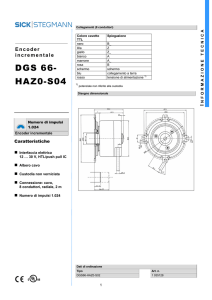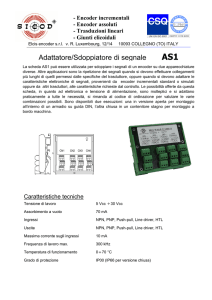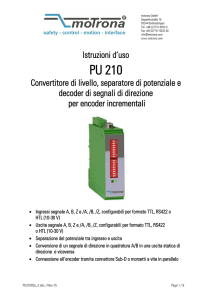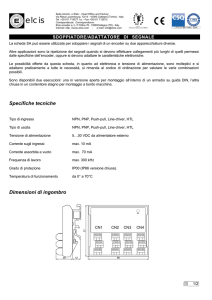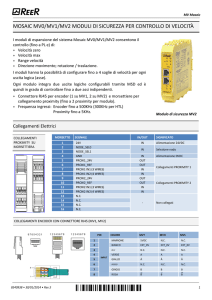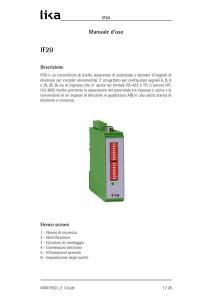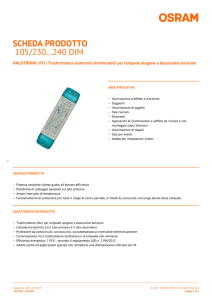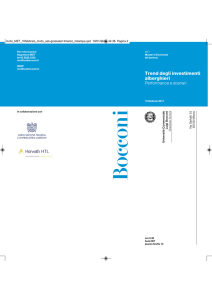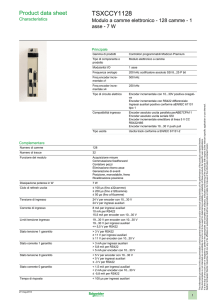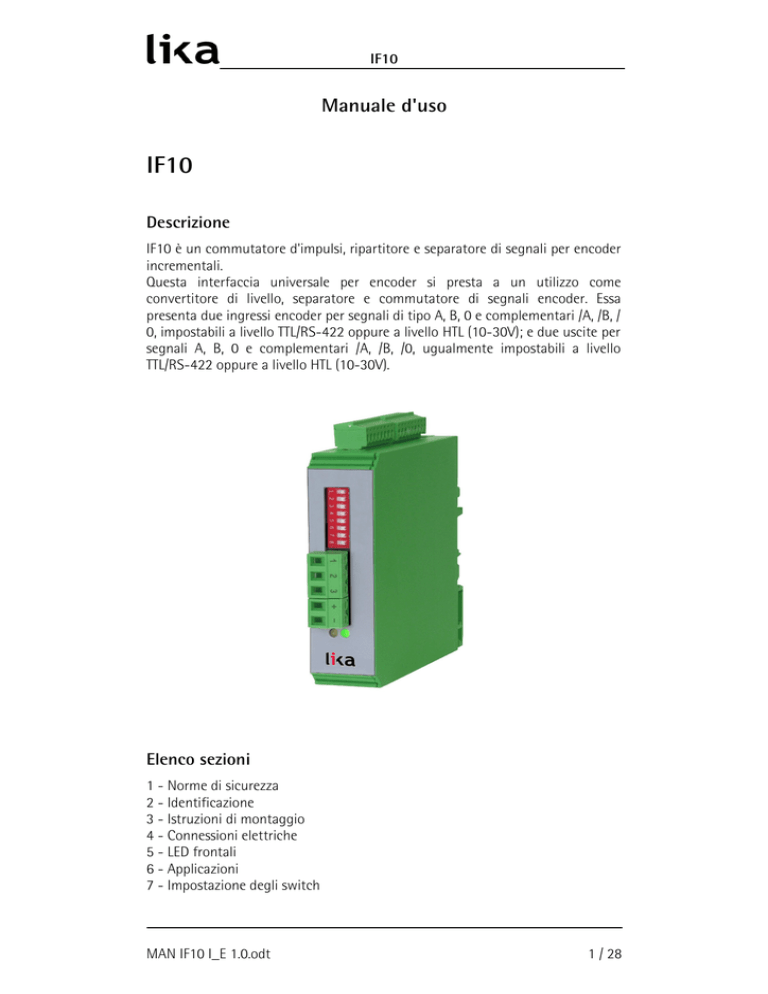
IF10
Manuale d'uso
IF10
Descrizione
IF10 è un commutatore d'impulsi, ripartitore e separatore di segnali per encoder
incrementali.
Questa interfaccia universale per encoder si presta a un utilizzo come
convertitore di livello, separatore e commutatore di segnali encoder. Essa
presenta due ingressi encoder per segnali di tipo A, B, 0 e complementari /A, /B, /
0, impostabili a livello TTL/RS-422 oppure a livello HTL (10-30V); e due uscite per
segnali A, B, 0 e complementari /A, /B, /0, ugualmente impostabili a livello
TTL/RS-422 oppure a livello HTL (10-30V).
Elenco sezioni
1 - Norme di sicurezza
2 - Identificazione
3 - Istruzioni di montaggio
4 - Connessioni elettriche
5 - LED frontali
6 - Applicazioni
7 - Impostazione degli switch
MAN IF10 I_E 1.0.odt
1 / 28
IF10
1 - Norme di sicurezza
1.1 Sicurezza
• Durante l’installazione e l’utilizzo del dispositivo osservare le norme di
prevenzione e sicurezza sul lavoro previste nel proprio paese;
• l’installazione e le operazioni di manutenzione devono essere eseguite da
personale qualificato, in assenza di tensione e parti meccaniche in
movimento;
• utilizzare il dispositivo esclusivamente per la funzione per cui è stato
costruito: ogni altro utilizzo potrebbe risultare pericoloso per l'utilizzatore;
• alte correnti, tensioni e parti meccaniche in movimento possono causare
lesioni serie o fatali;
• non utilizzare in ambienti esplosivi o infiammabili;
• il mancato rispetto delle norme di sicurezza o delle avvertenze specificate
in questo manuale è considerato una violazione delle norme di sicurezza
standard previste dal costruttore o richieste dall'uso per cui lo strumento è
destinato;
• Lika Electronic s.r.l. non si assume alcuna responsabilità per eventuali danni
o lesioni derivanti dall'inosservanza delle norme di sicurezza da parte
dell'utilizzatore.
1.2 Avvertenze elettriche
• Effettuare le connessioni elettriche esclusivamente in assenza di tensione;
• rispettare le istruzioni relative alle connessioni riportate nella sezione “4 Connessioni elettriche”;
• in conformità alla normativa 2004/108/CE sulla compatibilità
elettromagnetica rispettare le seguenti precauzioni:
- prima di maneggiare e installare il dispositivo, eliminare la presenza di
carica elettrostatica dal proprio corpo e dagli utensili che verranno in
contatto con il dispositivo;
- alimentare il dispositivo con tensione stabilizzata e priva di disturbi, se
necessario, installare appositi filtri EMC all’ingresso dell’alimentazione;
- utilizzare sempre cavi schermati e possibilmente “twistati”;
- non usare cavi più lunghi del necessario;
- evitare di far passare il cavo dei segnali del dispositivo vicino a cavi di
potenza;
- installare il dispositivo il più lontano possibile da eventuali fonti di
interferenza o schermarlo in maniera efficace;
- minimizzare i disturbi collegando l'unità a un buon punto di terra (GND).
Assicurarsi che il punto di terra sia privo di disturbi. Il collegamento a terra
può essere effettuato sul lato dispositivo e/o sul lato utilizzatore; è compito
dell’utilizzatore valutare la soluzione migliore da adottare per minimizzare i
disturbi.
MAN IF10 I_E 1.0.odt
1 - Norme di sicurezza
2 / 28
IF10
1.3 Avvertenze meccaniche
• Montare il dispositivo rispettando rigorosamente le istruzioni riportate
nella sezione “3 - Istruzioni di montaggio”;
• non disassemblare il dispositivo;
• non eseguire lavorazioni meccaniche sul dispositivo;
• dispositivo elettronico delicato: maneggiare con cura; evitare urti o forti
sollecitazioni sia all’albero che al corpo del dispositivo;
• utilizzare il dispositivo in accordo con le caratteristiche ambientali previste
dal costruttore.
2 - Identificazione
Il dispositivo è identificato mediante un codice di ordinazione e un numero di
serie stampati sull'etichetta applicata al dispositivo stesso; i dati sono ripetuti
anche nei documenti di trasporto che lo accompagnano. Citare sempre il codice
di ordinazione e il numero di serie quando si contatta Lika Electronic s.rl. per
l'acquisto di un ricambio o nella necessità di assistenza tecnica. Per ogni
informazione sulle caratteristiche tecniche del dispositivo fare riferimento al
catalogo del prodotto.
MAN IF10 I_E 1.0.odt
2 - Identificazione
3 / 28
IF10
3 - Istruzioni di montaggio
ATTENZIONE
Effettuare il montaggio meccanico esclusivamente in assenza di tensione.
L'interfaccia universale per encoder IF10 deve essere installata e protetta
all'interno di un quadro elettrico. Dispone di sistema di fissaggio secondo le
norme DIN e può perciò essere agevolmente montata su guide DIN mediante le
clip predisposte nella parte posteriore che non richiedono ulteriori supporti.
102 (4.016”)
91 (3.583”)
Front view
82.5 (3.248”)
102 (4.016”)
ON
22.5
(0.886”)
Side view
Top view
MAN IF10 I_E 1.0.odt
3 - Istruzioni di montaggio
4 / 28
IF10
4 - Connessioni elettriche
ATTENZIONE
Effettuare le connessioni elettriche esclusivamente in assenza di tensione.
5.2V
GND
A
A
B
B
Z
Z
24V
GND
A
A
B
Z
B
9 8 7 6 5 4 3 2 1
Terminal strip 8-pos.
Terminal strip 9-pos.
DIL Switch
X5
X4
Connectors are mechanically
coded and therefore not
interchangeable
3 2 1
Control 1
Control 2
GND
24V
GND
Input 1
8 7 6 5 4 3 2 1
X6
2 1
8 7 6 5 4 3 2 1
Z
Output 1
X1 Power supply
LED
X2
X3
5.2V
GND
Input 2
A
A
B
B
Z
Z
24V
GND
Output 2
A
A
B
1 2 3 4 5 6 7 8 9
B
1 2 3 4 5 6 7 8
Z
Terminal strip 9-pos.
Z
Terminal strip 8-pos.
4.1 Alimentazione
L'unità IF10 richiede un'alimentazione DC esterna compresa tra 12 e 30V
erogata attraverso la morsettiera a due poli sul pannellino frontale (morsetto a
vite 1 = +, morsetto a vite 2 = GND).
Il consumo di corrente è di circa 50 mA (tensione ausiliaria e uscite a vuoto).
4.2 Ingressi di controllo
Gli ingressi di controllo sono disponibili nella morsettiera a tre poli sul
pannellino frontale. Quando non sono collegati, il loro livello logico è BASSO. La
commutazione degli ingressi al livello logico ALTO si realizza mediante
l'applicazione nel rispettivo morsetto di un segnale di tensione compresa tra
+10 e +30V.
4.3 Ingressi encoder
Lo switch DIL permette l'impostazione degli ingressi secondo le specifiche
esigenze. Sono possibili i seguenti formati:
• Segnali single-ended (asimmetrici), solo canali A, B e 0 senza segnali
invertiti (normalmente il livello è HTL 10–30V, eccezionalmente anche
TTL, si veda la sezione “4.4 Ingressi asimmetrici di livello TTL“ a pagina 6).
MAN IF10 I_E 1.0.odt
4 - Connessioni elettriche
5 / 28
IF10
•
Segnali differenziali (simmetrici), canali A, /A, B, /B, 0, /0 (livelli secondo
lo standard RS-422 o TTL o HTL 10-30V).
Quando lo si desideri, gli ingressi A, B e 0 possono essere impostati come segnali
singoli indipendenti, per esempio se forniti da sensori di prossimità, fotocellule,
ecc. Dato che il livello di ogni canale può essere impostato singolarmente (si
veda lo switch DIL a pagina 11), i segnali in ingresso possono presentare livelli
differenti. E' perciò per esempio possibile ricavare l'informazione di posizione
tramite i canali A, /A, B e /B di un encoder RS-422, aggiungendo però il
corrispondente impulso di index 0 come segnale HTL proveniente da una
fotocellula remota.
Con segnali HTL, la soglia di commutazione si situa tra 6.5 e 8V. L'ingresso
utilizza un resistore pull-down interno di 5kOhms.
Ciascuno dei due morsetti degli ingressi fornisce due uscite di tensione ausiliaria
per l'alimentazione di un encoder: +5.2V/125 mA e +24V*/125 mA.
*) Uscita = tensione di alimentazione – 2V
4.4 Ingressi asimmetrici di livello TTL
In casi eccezionali è possibile processare segnali in ingresso di livello TTL
asimmetrici (per esempio: segnali TTL senza segnali complementari). Quando si
presenta una simile necessità, bisogna programmare lo switch DIL disponibile
sotto la maschera del pannellino frontale. Per accedere a questo switch
normalmente nascosto, sollevare leggermente la maschera nella parte inferiore
del pannellino frontale come illustrato nella figura, utilizzando, per esempio, un
piccolo cacciavite.
La posizione 1 dello switch incide su
tutti i canali dell'ingresso 1
La posizione 2 dello switch incide su
tutti i canali dell'ingresso 2
OFF = Formato asimmetrico a livello
HTL (10 – 30V)
ON = Formato asimmetrico a livello
TTL
In applicazioni standard non modificare le impostazioni dello switch DIL
occultato sotto la maschera del pannellino frontale!
MAN IF10 I_E 1.0.odt
4 - Connessioni elettriche
6 / 28
IF10
ATTENZIONE
I segnali asimmetrici a livello TTL sono estremamente sensibili ai rumori e alle
interferenze elettromagnetiche, non sono perciò consigliabili per la trasmissione
a distanza in ambienti industriali!
NOTA
Per default entrambe le posizioni dello switch sono impostate a OFF, cioè per
segnali asimmetrici single-ended a livello HTL (configurazione normale).
4.5 Uscite
Le uscite utilizzano stadi push-pull. Quando impostate a livello TTL/RS-422, il
corrispondente livello degli impulsi d'uscita è sempre di 5V. Quando invece sono
impostate al livello HTL, il livello degli impulsi d'uscita dipende dalla tensione di
alimentazione (12 – 30V).
Tutte le uscite sono protette contro il corto-circuito.
Sia i segnali normali che i corrispondenti segnali complementari sono sempre
disponibili in uscita, anche quando i segnali invertiti non siano collegati in
ingresso.
MAN IF10 I_E 1.0.odt
4 - Connessioni elettriche
7 / 28
IF10
5 - LED frontali
Il LED verde si accende non appena si fornisce tensione all'unità.
Il LED giallo indica lo stato degli ingressi di controllo e la funzione di base
dell'unità:
LED giallo OFF: gli ingressi di controllo 1 e 2 sono entrambi
contemporaneamente a livello logico BASSO oppure ALTO. In questo caso l'unità
opera come separatore d'impulsi (entrambe le uscite sono collegate allo stesso
ingresso).
LED giallo ON: gli ingressi di controllo 1 e 2 hanno stato differente. In questo
caso l'unità opera come convertitore a due livelli oppure come commutatore (le
uscite sono collegate a ingressi diversi).
MAN IF10 I_E 1.0.odt
5 - LED frontali
8 / 28
IF10
6 - Applicazioni
6.1 Convertitore a due livelli
RS422 or
HTL 10-30V
Control 1
= LOW
HTL 10-30V
or RS422
A, /A, B, /B, Z, / Z
A, /A, B, /B, Z, / Z
In1
Out1
In2
Out2
A, /A, B, /B, Z, / Z
A, /A, B, /B, Z, / Z
RS422 or
HTL 10-30V
HTL 10-30V
or RS422
Control 2
= HIGH
Entrambi gli ingressi possono essere impostati singolarmente al formato
simmetrico (differenziale) con utilizzo dei canali A, /A, B, /B, 0, /0 oppure al
formato asimmetrico (single-ended) con utilizzo dei soli canali A, B, 0.
I livelli di ingresso accettabili sono RS-422, TTL e HTL 10-30V.
Anche il formato in uscita può essere impostato singolarmente per ciascuna
uscita.
Le uscite forniscono sempre tutti i segnali, compresi quelli complementari,
anche quando i segnali invertiti non siano forniti in ingresso.
Con ingresso di controllo 1 = BASSO (o non collegato) e ingresso di controllo 2
= ALTO, lo schema dei segnali corrisponde all'immagine in alto, che rappresenta
una conversione di livello indipendente di due encoder.
6.2 Separatore encoder (doppia uscita)
RS422 or
HTL 10-30V
Control 1
= LOW (n.c.)
A, /A, B, /B, Z, / Z
N.C.
HTL 10-30V
or RS422
A, /A, B, /B, Z, / Z
In1
Out1
In2
Out2
A, /A, B, /B, Z, / Z
Control 2
= LOW (n.c.)
HTL 10-30V
or RS422
L'encoder è collegato all'ingresso 1, mentre l'ingresso 2 rimane non collegato.
L'ingresso può essere impostato al livello simmetrico (differenziale) con utilizzo
dei canali A, /A, B, /B, 0, /0 o al formato asimmetrico (single-ended) con utilizzo
dei soli canali A, B, 0.
I livelli di ingresso accettabili sono RS-422, TTL e HTL 10-30V.
Anche in questo caso il formato d'uscita può essere configurato singolarmente
per ciascuna uscita. Le uscite forniscono sempre tutti i segnali, compresi quelli
complementari, anche quando i segnali invertiti non siano forniti in ingresso. In
questa applicazione gli ingressi di controllo 1 e 2 rimangono non collegati.
MAN IF10 I_E 1.0.odt
6 - Applicazioni
9 / 28
IF10
6.3 Commutatore per segnali encoder
RS422 or
HTL 10-30V
Control 1
LO = In1, Hi = In2
A, /A, B, /B, Z, / Z
A, /A, B, /B, Z, / Z
In1
Out1
In2
Out2
A, /A, B, /B, Z, / Z
RS422 or
HTL 10-30V
HTL 10-30V
or RS422
A, /A, B, /B, Z, / Z
Control 2
LO = In1, HI = In2
HTL 10-30V
or RS422
Entrambi gli ingressi possono essere impostati singolarmente al formato
simmetrico (differenziale) con utilizzo dei canali A, /A, B, /B, 0, /0 oppure al
formato asimmetrico (single-ended) con utilizzo dei soli canali A, B, 0.
I livelli di ingresso accettabili sono RS-422, TTL e HTL 10-30V.
Anche in questo caso il formato d'uscita può essere configurato singolarmente
per ciascuna uscita.
Le uscite forniscono sempre tutti i segnali, compresi quelli complementari,
anche quando i segnali invertiti non siano forniti in ingresso.
Gli ingressi di controllo 1 e 2 permettono di selezionare il tipo di commutazione
del segnale:
BASSO: l'uscita corrispondente è collegata all'ingresso 1.
ALTO: l'uscita corrispondente è collegata all'ingresso 2.
MAN IF10 I_E 1.0.odt
6 - Applicazioni
10 / 28
IF10
7 - Impostazione degli switch
Lo switch DIL permette di impostare il livello e il formato degli ingressi e delle
uscite.
0=OFF
1=ON
8
7
Impostazione degli switch DIL
6
5
4
3
2
1
0 Uscita 1: TTL / RS-422
1 Uscita 1: HTL
0
Uscita2: TTL / RS-422
1
Uscita 2: HTL
Il livello delle uscite è 5V nel
caso di impostazione TTL,
mentre è in rapporto alla
tensione di alimentazione
con impostazione HTL.
0 0 0
(0) (B) (A)
Ingresso 1: differenziale
(canali A, B, 0, con
complementari /A, /B, /0)
Sono necessari sia l'ingresso
che il relativo
complementare. Sono
ammessi i livelli tra 2 e 30V.
1 1 1
(0) (B) (A)
Ingresso 1: single-ended,
solo canali A, B, 0 con
livello HTL*
Gli ingressi complementari
rimangono scollegati, il
livello deve essere HTL 1030V.
0 0 0
(0) (B) (A)
Ingresso 2: differenziale
(canali A, B, 0, con
complementari /A, /B, /0)
Sono necessari sia l'ingresso
che il relativo
complementare. Sono
ammessi i livelli tra 2 e 30V.
1 1 1
(0) (B) (A)
Ingresso 2: single-ended,
solo canali A, B, 0 con
livello HTL*
Gli ingressi complementari
rimangono scollegati, il
livello deve essere HTL 1030V.
*) Questa impostazione può essere utilizzata anche per segnali asimmetrici
(single-ended) di livello TTL. Si veda la sezione “4.4 Ingressi asimmetrici di livello
TTL” a pagina 6.
NOTA
Gli ingressi non utilizzati devono essere sempre impostati come “single-ended”
livello HTL!
NOTA
Non è obbligatorio impostare lo stesso livello per tutti i canali di un ingresso. Le
indicazioni (A), (B), (0) nella tabella qui sopra mostrano quale posizione dello
switch attenga a quale canale.
MAN IF10 I_E 1.0.odt
7 - Impostazione degli switch
11 / 28
IF10
ESEMPIO
Quando si impostano le posizioni 3 e 4 dello switch a “0” mentre la posizione 5 è
impostata a “1”, l'ingresso 1 accetterà i segnali A, /A, B, /B a livello RS-422
standard e invece il segnale di index 0 come segnale single-ended a livello HTL.
Di conseguenza è possibile generare, per esempio, segnali index a partire da una
fotocellula remota a 24V, mentre gli impulsi sono forniti dalla simulazione
encoder RS-422 di un driver.
MAN IF10 I_E 1.0.odt
7 - Impostazione degli switch
12 / 28
Pagina lasciata intenzionalmente bianca
Versione documento
1.0
Descrizione
Prima pubblicazione
Lika Electronic
Via S. Lorenzo, 25 - 36010 Carrè (VI) - Italy
Tel. +39 0445 806600
Fax +39 0445 806699
Italy: eMail [email protected] - www.lika.it
World: eMail [email protected] - www.lika.biz
IF10
User's manual
IF10
Description
IF10 is a cross switcher and splitter for incremental encoder signals.
This universal encoder interface is applicable as level converter, encoder splitter
and encoder cross switch. It provides two encoder inputs A, B, 0 and /A, /B, /0,
adjustable to either TTL/RS-422 level or HTL (10-30 volts) level; and two signal
outputs A, B, 0 and /A, /B, /0, likewise adjustable to either TTL/RS-422 level or
HTL (10-30 volts) level.
Table of contents
1 - Safety summary
2 - Identification
3 - Mounting instructions
4 - Electrical connections
5 - Front LEDs
6 - Applications
7 - Setting the switches
MAN IF10 I_E 1.0.odt
15 / 28
IF10
1 - Safety summary
1.1 Safety
• Always adhere to the professional safety and accident prevention
regulations applicable to your country during device installation and
operation;
• installation and maintenance operations have to be carried out by qualified
personnel only, with power supply disconnected and stationary mechanical
parts;
• device must be used only for the purpose appropriate to its design: use for
purposes other than those for which it has been designed could result in
serious personal and/or the environment damage;
• high current, voltage and moving mechanical parts can cause serious or
fatal injury;
• warning ! Do not use in explosive or flammable areas;
• failure to comply with these precautions or with specific warnings
elsewhere in this manual violates safety standards of design, manufacture,
and intended use of the equipment;
• Lika Electronic s.r.l. assumes no liability for the customer's failure to comply
with these requirements.
1.2 Electrical safety
• Turn OFF power supply before connecting the device;
• connect according to explanation in section ”4 - Electrical connections”;
• in compliance with 2004/108/EC norm on electromagnetic
compatibility, following precautions must be taken:
- before handling and installing the equipment, discharge
electrical charge from your body and tools which may come in touch with
the device;
- power supply must be stabilized without noise; install EMC filters on
device power supply if needed;
- always use shielded cables (twisted pair cables whenever possible);
- avoid cables runs longer than necessary;
- avoid running the signal cable near high voltage power cables;
- mount the device as far as possible from any capacitive or inductive noise
source; shield the device from noise source if needed;
- minimize noise by connecting the unit to ground (GND). Make sure that
ground (GND) is not affected by noise. The connection point to ground can
be situated both on the device side and on user’s side. The best solution to
minimize the interference must be carried out by the user.
1.3 Mechanical safety
• Install the device following strictly the information in the section “3 Mounting instructions”;
• do not disassemble the unit;
• do not tool the unit;
• delicate electronic equipment: handle with care; do not subject the device
and the shaft to knocks or shocks;
• respect the environmental characteristics of the device.
MAN IF10 I_E 1.0.odt
1 - Safety summary
16 / 28
IF10
2 - Identification
Device can be identified through the ordering code and the serial number
printed on the label applied to its body. Information is listed in the delivery
document too. Please always quote the ordering code and the serial number
when reaching Lika Electronic s.r.l. for purchasing spare parts or needing
assistance. For any information on the technical characteristics of the product,
refer to the technical catalogue.
3 - Mounting instructions
WARNING
Mount the unit with power supply disconnected.
IF10 universal encoder interface must be installed and protected inside the
electric panel. It provides DIN rail mounting and can quickly snap onto a DIN rail
with built-in DIN rail clips that require no additional brackets or supports.
102 (4.016”)
91 (3.583”)
Front view
82.5 (3.248”)
102 (4.016”)
ON
22.5
(0.886”)
Side view
Top view
MAN IF10 I_E 1.0.odt
3 - Mounting instructions
17 / 28
IF10
4 - Electrical connections
WARNING
Turn OFF the power supply before connecting the device.
5.2V
GND
A
A
B
B
Z
Z
24V
GND
A
A
B
Z
B
9 8 7 6 5 4 3 2 1
Terminal strip 8-pos.
Terminal strip 9-pos.
DIL Switch
X5
X4
Connectors are mechanically
coded and therefore not
interchangeable
3 2 1
Control 1
Control 2
GND
24V
GND
Input 1
8 7 6 5 4 3 2 1
X6
2 1
8 7 6 5 4 3 2 1
Z
Output 1
X1 Power supply
LED
X2
X3
5.2V
GND
Input 2
A
A
B
B
Z
Z
24V
GND
Output 2
A
A
B
1 2 3 4 5 6 7 8 9
B
1 2 3 4 5 6 7 8
Z
Terminal strip 9-pos.
Z
Terminal strip 8-pos.
4.1 Power supply
The unit requires 12–30 volts DC power supply via the 2-position power
terminal on the front side (terminal 1 = +, terminal 2 = GND).
The current consumption is about 50 mA (aux. voltages and outputs unloaded).
4.2 Control inputs
The control inputs are accessible via the 3-position terminal strip on the front.
They are in LOW state when unconnected. To switch the inputs to HIGH state, a
signal from +10 to +30 volts must be applied to the corresponding terminal.
4.3 Encoder inputs
The input lines can be configured for different requirements by DIL switch
setting. The following input formats can be used:
• Single-ended signals (asymmetric), channels A, B and 0 only without
inverted inputs (level is HTL 10–30 volts in general, exceptionally also
TTL, see section “4.4 Asymmetric TTL Inputs“ on page 19).
• Differential signals (symmetric), channels A, /A, B, /B, 0, /0 (levels either
according to RS-422 standard or TTL or HTL 10-30 volts).
MAN IF10 I_E 1.0.odt
4 - Electrical connections
18 / 28
IF10
A, B and 0 may at any time also be independent single signals, e.g. from
proximities, photocells etc. Since the level of every channel is selected
individually (see DIL-switch on page 24), it is possible to use different levels on
the inputs. Consequently it is e.g. possible to take the position information from
the A, /A, B and /B channels of a RS-422 encoder, but to add the corresponding
0 index pulse as a HTL signal from a remote photocell.
With HTL signals, the switching threshold lies between 6.5 and 8 volts. The input
uses an internal pull-down resistor of 5kOhms.
Every of the two input terminals provides two auxiliary voltage outputs for easy
encoder supply: +5.2 volts/125 mA and +24 volts*/125 mA.
*) Output = power supply voltage – 2 volts
4.4 Asymmetric TTL Inputs
Only when exceptionally asymmetric TTL input signals must be processed (i.e. TTL
signals without inverted signal), a 2-position DIL switch located behind the front
plate must be set. This hidden switch becomes accessible by slightly lifting up
the front foil in the bottom (e.g. by means of a small screw driver).
Switch position 1 affects all channels
of Input 1
Switch position 2 affects all channels
of Input 2
OFF = Asymmetric operation with HTL
level (10 – 30 V)
ON = Asymmetric operation with TTL
level
For all general applications please do not touch the DIL switch hidden
under the front plate !
WARNING
Asymmetric TTL levels are most sensitive to noise and interference, therefore not
suitable for cable transmission in an industrial environment!
NOTE
Ex factory both switches are OFF, i.e. any single-ended operation requires HTL
levels (this is the normal case).
MAN IF10 I_E 1.0.odt
4 - Electrical connections
19 / 28
IF10
4.5 Outputs
The outputs provide push-pull characteristics. When set to TTL/RS-422 level, the
corresponding output swing is always 5 volts. When set to HTL, the output
swing depends on the power supply input (12 – 30 volts).
All outputs are short-circuit-proof.
At any time the signal and the appropriate inverted signal are both available at
the output, even when no inverted signal is applied to the input.
MAN IF10 I_E 1.0.odt
4 - Electrical connections
20 / 28
IF10
5 - Front LEDs
The green LED is lit as soon as power supply voltage is applied to the unit.
The yellow LED indicates the state of the control inputs and the basic function
of the unit:
Yellow LED OFF: Control1 and Control2 are either both LOW or both HIGH at
the same time. In this case the unit operates as a splitter (both outputs are
connected to the same input).
Yellow LED ON: Control1 and Control2 have different states. In this case the
unit operates as a dual level converter or as a switcher (the outputs are
connected to different inputs).
MAN IF10 I_E 1.0.odt
5 - Front LEDs
21 / 28
IF10
6 - Applications
6.1 Dual level converter
RS422 or
HTL 10-30V
Control 1
= LOW
HTL 10-30V
or RS422
A, /A, B, /B, Z, / Z
A, /A, B, /B, Z, / Z
In1
Out1
In2
Out2
A, /A, B, /B, Z, / Z
A, /A, B, /B, Z, / Z
RS422 or
HTL 10-30V
HTL 10-30V
or RS422
Control 2
= HIGH
Both inputs can be individually set to either symmetric (differential) format
using A, /A, B, /B, 0, /0 channels or to asymmetric (single-ended) format using A,
B, 0 channels only.
Acceptable input levels are RS-422, TTL and HTL 10-30 volts.
The output format can again be selected individually for each output.
The outputs provide always all signals including the inverted channels, even
when no inverted signals are applied to the input.
With Control input 1 = LOW (or unconnected) and Control input 2 = HIGH the
signal ways are as shown in the drawing above, featuring two independent level
converters.
6.2 Encoder splitter (dual output)
RS422 or
HTL 10-30V
Control 1
= LOW (n.c.)
A, /A, B, /B, Z, / Z
N.C.
HTL 10-30V
or RS422
A, /A, B, /B, Z, / Z
In1
Out1
In2
Out2
A, /A, B, /B, Z, / Z
Control 2
= LOW (n.c.)
HTL 10-30V
or RS422
Input 1 is used as encoder input and Input 2 remains unconnected. The input
can be set to either symmetric (differential) format using A, /A, B, /B, 0, /0
channels or to asymmetric (single-ended) format using A, B, 0 channels only.
Acceptable input levels are RS-422, TTL and HTL 10-30 volts.
The output standard can again be selected individually for each output. The
outputs provide always all signals including the inverted channels, even when
no inverted signals are applied to the input. Control1 and Control2 remain
unconnected with this application.
MAN IF10 I_E 1.0.odt
6 - Applications
22 / 28
IF10
6.3 Encoder signal switcher
RS422 or
HTL 10-30V
Control 1
LO = In1, Hi = In2
A, /A, B, /B, Z, / Z
A, /A, B, /B, Z, / Z
In1
Out1
In2
Out2
A, /A, B, /B, Z, / Z
RS422 or
HTL 10-30V
HTL 10-30V
or RS422
A, /A, B, /B, Z, / Z
Control 2
LO = In1, HI = In2
HTL 10-30V
or RS422
Both inputs can be individually set to either symmetric (differential) format
using A, /A, B, /B, 0, /0 channels or to asymmetric (single-ended) format using A,
B, 0 channels only.
Acceptable input levels are RS-422, TTL and HTL 10-30 volts.
The output standard can again be selected individually for each output.
The outputs provide always all signals including the inverted channels, even
when no inverted signals are applied to the input.
Inputs Control1 and Control2 select the signal ways:
LOW: the corresponding output is connected to input 1.
HIGH: the corresponding output is connected to input 2.
MAN IF10 I_E 1.0.odt
6 - Applications
23 / 28
IF10
7 - Setting the switches
The DIL switch sets level and standard of inputs and outputs.
0=OFF
1=ON
8
7
DIL switch settings
6
5
4
3
2
0
1
1
0 Output 1: TTL / RS-422 The output levels are 5
volts with TTL setting
1 Output 1: HTL
and correspond to the
Output 2: TTL / RS-422 power supply voltage
with HTL setting.
Output 2: HTL
0 0 0
(0) (B) (A)
Input 1: differential
(A, /A, B, /B, 0, /0)
Both input and
inverted input must be
used. Levels from 2 to
30 volts are
acceptable.
1 1 1
(0) (B) (A)
Input 1: single-ended
(A,B,0) with HTL level *
Inverted inputs remain
open, level must be
HTL 10-30 volts.
0 0 0
(0) (B) (A)
Input 2: differential
(A, /A, B, /B, 0, /0)
Both input and
inverted input must be
used. Levels from 2 to
30 volts are
acceptable.
1 1 1
(0) (B) (A)
Inverted inputs remain
Input 2: single-ended
open, level must be
(A, B, 0) with HTL level *
HTL 10-30 volts.
*) This setting can also be used with asymmetric (single-ended) TTL levels. See
section “4.4 Asymmetric TTL Inputs” on page 19.
NOTE
Please set unused input lines to “single-ended” HTL at any time!
NOTE
It is not mandatory to use the same level for all channels of an input. The
indications (A), (B), (0) show which switch position is responsible for which
channel.
MAN IF10 I_E 1.0.odt
7 - Setting the switches
24 / 28
IF10
EXAMPLE
When e.g. positions 3 and 4 are set to “0” and position 5 is set to “1”, Input1
would accept A, /A, B, /B at RS-422 standard and the 0 index as a HTL singleended signal.
Consequently it is possible to generate, for instance, an Index from a remote
photocell, whereas the impulses come from the RS-422 encoder simulation of a
drive system.
MAN IF10 I_E 1.0.odt
7 - Setting the switches
25 / 28
This page intentionally left blank
This page intentionally left blank
Document release
1.0
Description
1st issue
Lika Electronic
Via S. Lorenzo, 25 - 36010 Carrè (VI) - Italy
Tel. +39 0445 806600
Fax +39 0445 806699
Italy: eMail [email protected] - www.lika.it
World: eMail [email protected] - www.lika.biz

